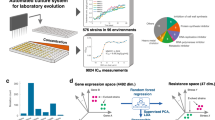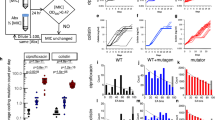Abstract
Antibiotic resistance is thought to evolve rapidly in response to antibiotic use. At present, we lack effective tools to assess how rapidly existing resistance genes are likely to evolve to yield resistance to newly introduced drugs. To address this problem, a method has been developed for in vitro evolution experiments to help predict how long it will take antibiotic resistance to arise — potentially allowing informed decisions about usage to be made.
This is a preview of subscription content, access via your institution
Access options
Subscribe to this journal
Receive 12 print issues and online access
$209.00 per year
only $17.42 per issue
Buy this article
- Purchase on SpringerLink
- Instant access to full article PDF
Prices may be subject to local taxes which are calculated during checkout


Similar content being viewed by others
References
Palumbi, S. R. Humans as the world's greatest evolutionary force. Science 293, 1786–1790 (2001).
Harrison, P. F. & Lederberg, J. (eds) Antimicrobial Resistance: Issues and Options (National Academy Press, Washington DC, 1998).
Interagency Task Force on Antimicrobial Resistance. A public health action plan to combat antimicrobial resistance. [online], <http://www.cdc.gov/drugresistance/actionplan/aractionplan.pdf> (1999).
National Antimicrobial Resistance Monitoring System Annual Report 2000 [online], <http://www.cdc.gov/narms/annual/2000/narms_2000_annual_a.htm> (2000).
Walsh, C. Where will new antibiotics come from? Nature Rev. Microbiol. 1, 65–70 (2003).
Hall, R. M. & Stokes, H. W. Integrons: novel DNA elements which capture genes by site-specific recombination. Genetica 90, 115–132 (1993).
Livermore, D. Can better prescribing turn the tide of resistance? Nature Rev. Microbiol. 2, 73–78 (2004).
CDC Interagency Public Health Action Plan 2001 Annual Report [online], <http://www.cdc.gov/drugresistance/actionplan/2001report/index.htm> (2001).
Galewitz, P. Pharmacia and Upjohn readies new antibiotic. [online], <http://www.louisville.edu/~rmatla01/discus/messages/161/161.html> (1999).
Stemmer, W. P. C. Rapid evolution of a protein in vitro by DNA shuffling. Nature 370, 389–390 (1994).
Barlow, M. & Hall, B. G. Predicting evolutionary potential: in vitro evolution accurately reproduces natural evolution of the TEM β-lactamase. Genetics 160, 823–832 (2002).
Barlow, M. & Hall, B. G. Experimental prediction of the natural evolution of antibiotic resistance. Genetics 163, 1237–1241 (2003).
Barlow, M. & Hall, B. G. Experimental prediction of the evolution of cefepime resistance from the CMY-2 AmpC β-lactamase. Genetics 164, 23–29 (2003).
Salipante, S. J. & Hall, B. G. Determining the limits of the evolutionary potential of an antibiotic resistance gene. Mol. Biol. Evol. 20, 653–659 (2003).
Hall, B. G. In vitro evolution predicts that the IMP-1 metallo-β-lactamase does not have the potential to evolve increased activity toward imipenem. Antimicrob. Agents Chemother. 48, 1032–1033 (2004).
Barlow, M. & Hall, B. G. Origin and evolution of the AmpC β-lactamases of Citrobacter freundii. Antimicrob. Agents Chemother. 46, 1190–1198 (2002).
Barlow, M. & Hall, B. G. Phylogenetic analysis shows that the OXA β-lactamase genes have been on plasmids for millions of years. J. Mol. Evol. 55, 314–321 (2002).
Hall, B. G., Salipante, S. J. & Barlow, M. The metallo-β-lactamases fall into two distinct phylogenetic groups. J. Mol. Evol. 57, 249–254 (2003).
Hall, B. G. & Barlow, M. Structure-based phylogenies of the serine β-lactamases. J. Mol. Evol. 57, 255–260 (2003).
Hall, B. G., Salipante, S. J. & Barlow, M. Independent origins of the subgroup (B1 + B2) and the subgroup B3 metallo-β-lactamases. J. Mol. Evol. (in the press).
Magnet, S., Courvalin, P. & Lambert, T. Activation of the cryptic aac(6′)-Iy aminoglycoside resistance gene of Salmonella by a chromosomal deletion generating a transcriptional fusion. J. Bacteriol. 181, 6650–6655 (1999).
Podglajen, I., Breuil, J., Bordon, F., Gutmann, L. & Collatz, E. A silent carbapenemase gene in strains of Bacteroides fragilis can be expressed after a one-step mutation. FEMS Microbiol. Lett. 70, 21–29 (1992).
Salipante, S. J., Barlow, M. & Hall, B. G. GeneHunter: a transposon tool for the identification and isolation of cryptic antibiotic resistance genes. Antimicrob. Agents. Chemother. 47, 3840–3845 (2004).
Acknowledgements
The author's studies were supported by a grant from the National Institutes of Health.
Author's note
The computer program 'InVitro Evolution Simulator' is available free of charge on e-mail request to the author.
Author information
Authors and Affiliations
Ethics declarations
Competing interests
The author declares no competing financial interests.
Related links
Rights and permissions
About this article
Cite this article
Hall, B. Predicting the evolution of antibiotic resistance genes. Nat Rev Microbiol 2, 430–435 (2004). https://doi.org/10.1038/nrmicro888
Issue Date:
DOI: https://doi.org/10.1038/nrmicro888
This article is cited by
-
iTRAQ®-based quantitative proteomics reveals the proteomic profiling of methicillin-resistant Staphylococcus aureus-derived extracellular vesicles after exposure to imipenem
Folia Microbiologica (2021)
-
Microbiological and molecular insights on rare Actinobacteria harboring bioactive prospective
Bulletin of the National Research Centre (2020)
-
Indole contributes to tetracycline resistance via the outer membrane protein OmpN in Vibrio splendidus
World Journal of Microbiology and Biotechnology (2020)
-
Collateral sensitivity constrains resistance evolution of the CTX-M-15 β-lactamase
Nature Communications (2019)
-
Predicting the evolution of Escherichia coli by a data-driven approach
Nature Communications (2018)



